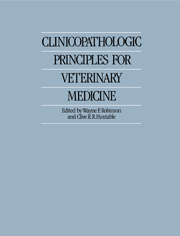Book contents
- Frontmatter
- Contents
- Contributors
- Preface
- Acknowledgements
- 1 The relationship between pathology and medicine
- 2 The immune system
- 3 The hematopoietic system
- 4 Acid–base balance
- 5 The respiratory system
- 6 The cardiovascular system
- 7 The alimentary tract
- 8 The liver and exocrine pancreas
- 9 The urinary system
- 10 The endocrine glands
- 11 The skin
- 12 The skeletal system
- 13 The nervous system
- 14 Muscle
- 15 Metabolic disease
- 16 The reproductive system
- Index
13 - The nervous system
Published online by Cambridge University Press: 19 January 2010
- Frontmatter
- Contents
- Contributors
- Preface
- Acknowledgements
- 1 The relationship between pathology and medicine
- 2 The immune system
- 3 The hematopoietic system
- 4 Acid–base balance
- 5 The respiratory system
- 6 The cardiovascular system
- 7 The alimentary tract
- 8 The liver and exocrine pancreas
- 9 The urinary system
- 10 The endocrine glands
- 11 The skin
- 12 The skeletal system
- 13 The nervous system
- 14 Muscle
- 15 Metabolic disease
- 16 The reproductive system
- Index
Summary
The nervous system is a communications network whose functions range from simple reflex activities to the complexities of awareness and conscious thought. Elements of the nervous system ramify to every part of the body, giving it a universal functional influence.
The functional integrity of the nervous system is directly related to the activity of neurons. When some noxious influence affects part of the nervous system, activity of the neurons in the area may cease, may be suppressed or may become excessive. In the central nervous system (CNS) these changes will inevitably affect other, interconnected, neurons and induce a change in their activity and coordination. The nervous system is arranged in a hierarchical manner so that dysfunction of one group of neurons is reflected as dysfunction of the subordinate neural pathways including those in the peripheral nervous system (PNS). The dysfunction may thus be projected widely throughout the system.
Fortunately for the clinician, the highly organized nature of the nervous system means that damage to a given area will always produce distinctively recognizable dysfunctions. With adequate clinical skills and an appreciation of the functional anatomy of the system, it is often possible to localize the seat of nervous dysfunction in an animal with neurologic disease.
The student is therefore advised to review the general anatomy of the nervous system along the lines indicated on p. 337, including the disposition of the meninges and the generation and flow-patterns of the cerebrospinal fluid.
- Type
- Chapter
- Information
- Clinicopathologic Principles for Veterinary Medicine , pp. 330 - 377Publisher: Cambridge University PressPrint publication year: 1988



